Little dramas
This post was originally titled Drama queens.
Apposite … it’s mostly about queens.
However, the term drama queen refers to someone who overreacts to a minor setback {{1}} … which is almost the complete opposite of what I’m intending to discuss.
Instead, this post is about the – sometimes unseen – little dramas in the apiary. Things that go wrong, or could go wrong but eventually go OK because you gently intervene … or often because you don’t intervene at all 😉
It’s also about observing rather than doing. It’s sometimes surprising what you see, and – with a little application – you can learn something about your bees {{2}}.
Of course, in the end some things do not end well … but there’s no point in being a drama queen about it 😉
There’s a certain predictability to the beekeeping year. It’s dictated by the climate and latitude, by the forage available, by the need for bees to reproduce (swarm) and by our efforts as beekeepers to corral them and keep them producing honey {{3}}.
All of which means that June has been pretty manic.
After a record-breakingly cold spring things finally warmed up. Here in Scotland this was 2-3 weeks into May.
Since then it’s been a near-constant round of queen rearing, swarm control, making up nucs and adding supers. Most of the OSR supers are now off, meaning that I’ll be hunched over the extractor for hours when I’m not with the bees 🙁
The rapid warming in late spring triggered a lot of swarming activity. I found my first charged queen cell on the 18th of May and, in at least one or two colonies, at every subsequent inspection since then.
Visits to the apiaries have been hard work. Inspecting a double brood colony with four full supers involves a lot of lifting {{4}}.
And the lifting is necessary because I need to check whether there are any queen cells in the brood chamber.
I know some beekeepers simply prise the two brood boxes apart and expect to see queen cells at the junction.
That certainly works … sometimes.
However, I’ve found several colonies with queen cells in the middle of frames, or otherwise in positions I would not see them if I just looked at the interface between the boxes.
And I would still have to remove the supers to prise the brood boxes apart.
Although I’ve invested in some better quality hive tools, I’d need a crowbar to separate the boxes if there was 80 kg of supers on top {{5}}.
So, if I have to take the supers off, I might as well look through the box carefully.
More haste, less speed
But before I fire up the smoker and start rushing around prising off crownboards I always try and simply observe what’s happening in the apiary.
Are all the colonies equally busy? If it’s the time of day when the new foragers are going on orientation flights are any colonies much less active? Have they had a brood break?
Which direction are the bees flying off or returning from? Has the main forage changed?
Are there any drones on orientation flights yet?
What’s happening at the hive entrances?
Is there pollen going in?
Any sign of fighting?
Or robbing?
It’s surprising what a few minutes observation can tell you about the local forage, the state of the colonies and their relative strength.
If you’ve not already read it (and even if you have) it’s worth finding a copy of At the Hive Entrance by Prof. H. Storch {{6}}. The book’s strap-line is “How to know what happens inside the hive by observation on the outside”. Recommended.
And, now and again, you notice something unusual …
Queen under the open mesh floor
Like – in my peripheral vision – a single bee flying out from underneath an open mesh floor.
My queens are generally clipped. If the colony swarms the queen often finds her way back to the hive stand after crashing – very unregally {{7}} – to the ground. She crawls up the leg of the stand and ends up underneath the open mesh floor (OMF).
The bees then join her. It’s not unusual to find a large cluster of bees under the hive floor, with lots of activity, and lots of bees flying to and fro from underneath the OMF {{8}}.
But last Friday, by chance I noticed a single bee and this prompted me to investigate.
A quick peek confirmed that there wasn’t a swarm under the OMF.
But there was a queen.
Almost completely alone.
I presume the colony had swarmed, the queen had got as far as she could and the swarm had eventually abandoned her and returned to the hive.
When I inspected the colony I found a single sealed queen cell and confirmed that the queen I found was the one that was missing.
This colony was one of my ‘middle third’ ones {{9}} … i.e. destined for requeening with better stock if I had any spares.
I did.
I had half a dozen ‘spare’ queen cells almost ready to emerge from grafting at the start of June. I removed the queen cell in the hive and carefully checked I’d not missed any others. I then added the grafted cell, seating it in a thumb-sized depression over some brood. She will have emerged the following day and might even be mated when I check early next week.
Had I not seen the bee emerge from under the floor I’d have never otherwise checked. There are always a few bees under an OMF, but it’s rare to find a queen all alone there.
Queen in the grass
In another apiary the previous week I’d found a satsuma-sized cluster of bees in long grass about 10 metres from the hives. The application of a little gentle smoke and some prodding around with my index finger resulted in a clipped and marked queen calmly walking up onto my hand.
Again, I wouldn’t have seen this had I not been taking my time checking the hive entrances and the activity in the apiary. I was being even more leisurely than normal as there was rain threatening and I was trying to decide whether to start the inspections or not
Because of the known state of other colonies in the apiary – most were nucs with virgin or recently-mated queens – it was obvious which colony the queen had come from.
The ‘threatening rain’ looked like it would soon become a certainty. I ran the queen in through the front entrance of the hive and the remaining bees eventually returned to the hive, fanning madly at the entrance.
When I next checked the hive the queen had gone 🙁
There was no sign the colony had swarmed, but there was a recently opened queen cell in there. I assumed there’s a newly emerged virgin queen running about in there with ‘blood on her hands’ having done away with the original queen.
We’ll find out next week.
Again, a few minutes just watching things in the apiary meant I found the queen. Had I not done so I’d have only seen the end result – a queenless colony – not the events that led to it.
Preventative and reactive swarm control
I should emphasise that the majority of my colonies are a little more under control than the two described above, both of which clearly attempted to swarm.
In both cases the clipped queen saved the day, even though she may not have lived to fight another day.
My swarm control (and success thereof) this season has been in stark contrast to last year’s ‘lockdown beekeeping’.
Then the priority was minimising travel and guaranteeing I wasn’t haemorrhaging swarms that might cause problems for the the public or other beekeepers.
I therefore used the nucleus method of swarm control on all my colonies. I implemented it well in advance of the peak swarming period. By doing so, I undoubtedly weakened my colonies. I produced less honey and did no queen rearing.
But I didn’t lose a single swarm 🙂
This year the priority has been to maintain strong colonies. Some are being used for honey production {{10}} and others are being split to make up nucs.
Inevitably a few have got a little ‘overcooked’ … but the clipped queen has usually ensured the bees remain in the hive.
I don’t think I’ve lost a swarm, but I have lost a few queens.
Queen in the cage
One of my colonies went queenless in mid May. This was well before I’d got any spare queens – mated or otherwise. I’d hoped that they would rear another, but it was too cold for the new queen to mate and the colony started to look a little pathetic.
I considered uniting them but, for a variety of reasons, never got round to it.
When I finally had a spare mated queen (in early June) I popped her into a JzBz introduction cage. I’d already plugged the tube with candy and placed a plastic cap over the end.
The bees could feed the queen through the cage, but could not release her.
This is my usual method for queen introduction. I check the cage a day or so after hanging it between the frames. If the bees are showing aggression to the queen I leave it and check again 24 hours later.
Once they’re no longer showing any aggression I remove the plastic cap. The bees chew through the candy and release the queen.
Job done 🙂
I then leave the colony at least a week before inspecting, by which time I expect to see eggs and larvae.
On returning a week after removing the plastic cap I was dismayed to find the queen still in the cage. Most of the candy had gone, but there was a plug at one end that was rock hard. Clearly the bees had been unable to release her.
The colony had now been broodless almost a month. Brood pheromone is really important in suppressing laying worker activity in the hive. Queen pheromone is no substitute for brood pheromone {{11}} and I was very concerned about the additional lost week due to my stupidity {{12}}.
But there was no point in being a drama queen … I opened the cage and gently released the queen onto a seam of bees. Five days later there are eggs and larvae (and the queen) in the hive, though I also think there are a few laying workers as there’s a smattering of drone pupae in worker cells (a classic sign).
Fingers crossed 🙂
Queen failure
The final ‘little drama’ was played out in full view over almost two months. Its eventual unsatisfactory conclusion was largely due to my procrastination … though I suspect a swallow or house martin may have hastened events at the end.
In late April, during one of the rare warm days it was possible to actually open a colony, I noticed some strange egg laying behaviour in one hive.
The colony was queenright. The queen was marked and clipped and laying. However, although she was laying single eggs in worker comb, she was laying multiple eggs in about 10% of cells, almost all of which were in drone comb.
A fortnight or so later she was still doing the same thing. Even if it wasn’t obvious to me, it was clearly obvious to the bees that the queen was failing as they started a couple of queen cells. Here’s an enlargement of an earlier photo in this post – blue arrows mark single eggs, red arrows indicate multiples.
I removed the queen and added a near-mature queen cell from my first round of grafting. She had emerged when I next checked, but was not yet laying (and I didn’t bother looking for her).
But, unlike the queen stuck in the cage, this didn’t have a happy ending.
By early June there was no sign of the queen and I fear she failed to return from a mating flight. There’s a big pond bear the apiary and it’s a magnet for swallows and house martins {{13}}.
I added a frame of open brood (including both young larvae and eggs) in the hive, but they ignored it {{14}}.
When I next checked it was clear there were laying workers and I cut my losses and shook the colony out.
In retrospect what should I have done?
I should have united the colony in mid-May.
It was obvious then – at least to the bees – that the queen was failing. I’d never seen a queen laying singles in worker comb {{15}} but multiples in drone cells.
Uniting would have immediately provided both brood pheromone and a laying queen. This would have suppressed the development of laying workers.
My notes go something like:
- 18/5 – Still laying singles in worker and multiples in drone. Weird. QC looks like supersedure. Give them a week.
- 26/5 – Q out. Didn’t check further. Decision time next week.
- 3/6 – Strange. Increasing drone brood. Behaving queenright. Decision time next week.
- 12/6 – Laying workers. Shook them out. Will I ever learn? EEJIT {{16}}
The second rule of beekeeping
Anytime I write Decision time next week (or variants thereof, like Give them another week) in two successive weeks then it’s almost always going to end in tears 🙁
If it happens three times in succession it’s a nailed on certainty.
The first rule is – of course – Knocking off queen cells is not swarm control 😉
{{1}}: And, for the etymologists amongst the readers, this dates back to an article in the Washington Post in April 1923 “If he is thwarted in his effort to enjoy them, he may either go to the dogs or the drama queens, become short-tempered, sullen, grouchy and eventually feel that, in a way he is a failure” … a near-perfect description of me when my beekeeping plans go awry.
{{2}}: Though, if you’re anything like me, you might have to repeat the lesson a few times.
{{3}}: Or pollinating, or collecting propolis or making Royal Jelly or ‘saving the bees’ or whatever floats your boat.
{{4}}: Though most are thankfully on a single brood box, including the most productive hive which ended up with 5 supers. Unheard of for my bees since moving back to Scotland.
{{5}}: A year or so ago I weighed a couple of dozen full supers before extraction. They weighed 17-23 kg each. I now guesttimate the average is 20 kg. This means that the first 16 I brought back to extract last weekend involved lifting something like one tonne; from the hives to the car to the honey warming cabinet in the extracting room. No wonder my back is sore.
{{6}}: There’s a PDF (of a rather poor photocopy) floating around on the internet which is easy to find. I know some of the ‘books’ for sale – Amazon I’m looking at you – are simply printed copies of this photocopy. Caveat emptor. Try Northern Bee Books who might have a better quality copy, though it might be worth calling Jeremy first to ask whether it’s an original or facsimile.
{{7}}: I don’t think that’s a real word.
{{8}}: And if you do, just drop them into a nuc box or skep, just as you would a swarm … which is what they are.
{{9}}: For an explanation see the post describing my ‘rule of thirds‘.
{{10}}: And it looks like it’s going to be a record spring in terms of honey/hive.
{{11}}: Oops … this might be incorrect as Elaine points out in the comments. There’s evidence that both brood pheromone and queen mandibular pheromone suppress laying worker development. Look forward to a future article on this … or not.
{{12}}: I usually keep a couple of ready-plugged JzBz cages in my beesuit pocket. The one I’d used might well have been there since last year. What a muppet.
{{13}}: Or maybe it’s the apiary that’s the magnet, and the pond just provides the garnish.
{{14}}: Sometimes (though not in my experience, which this event simply reinforced … why do I never learn?) the brood pheromone will suppress laying worker activity and they then rear a new queen from the eggs provided.
{{15}}: Though admittedly in a rather haphazard pattern …
{{16}}: Irish (and Scottish) slang for a procrastinating beekeeper who really should know better and acted sooner.

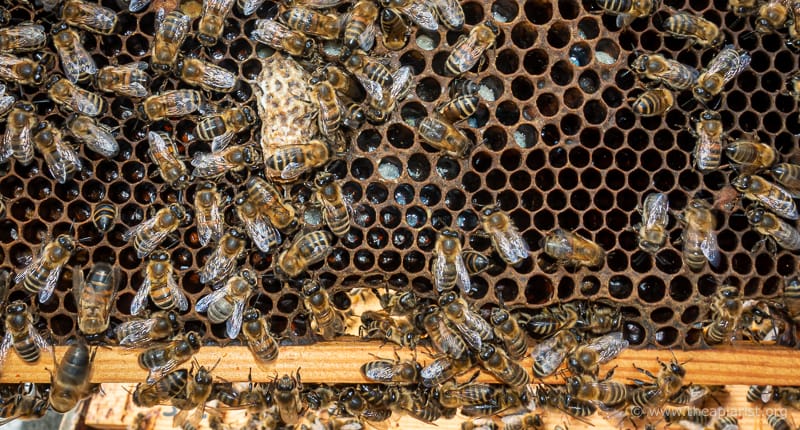
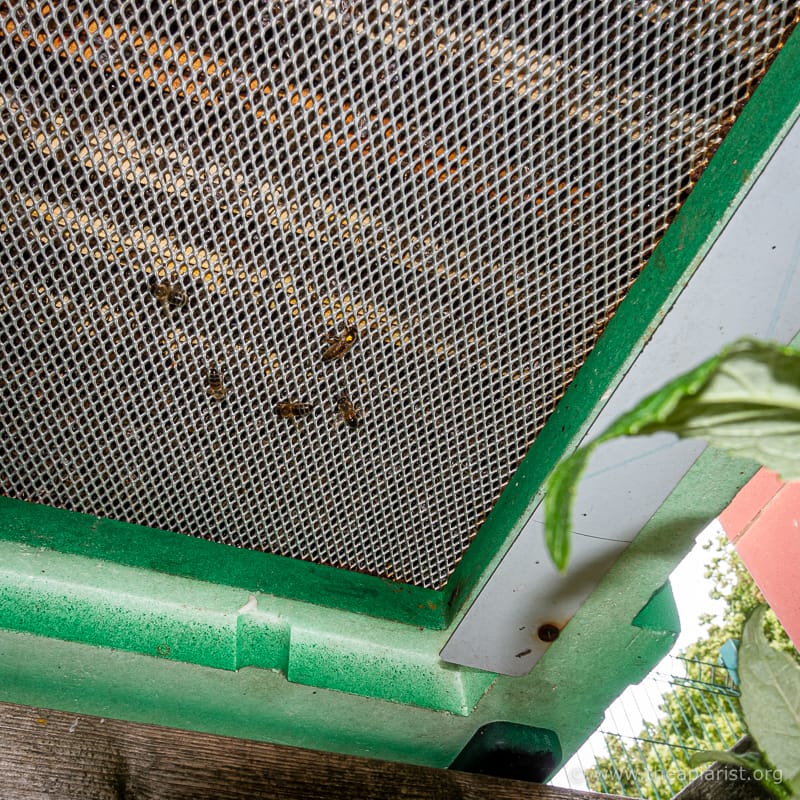

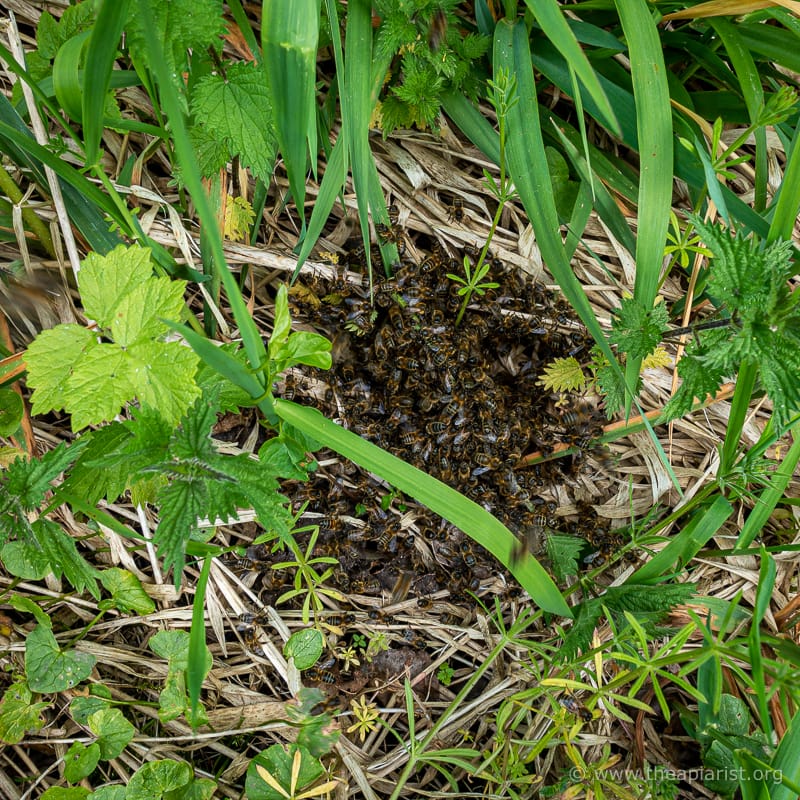

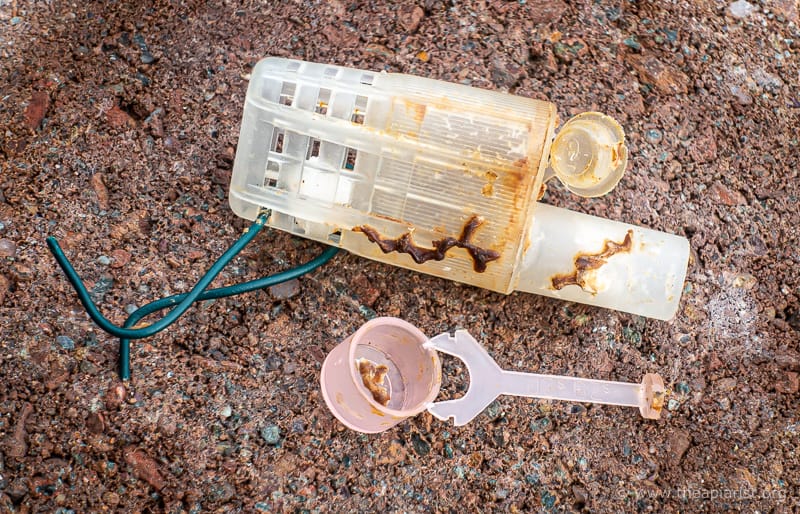

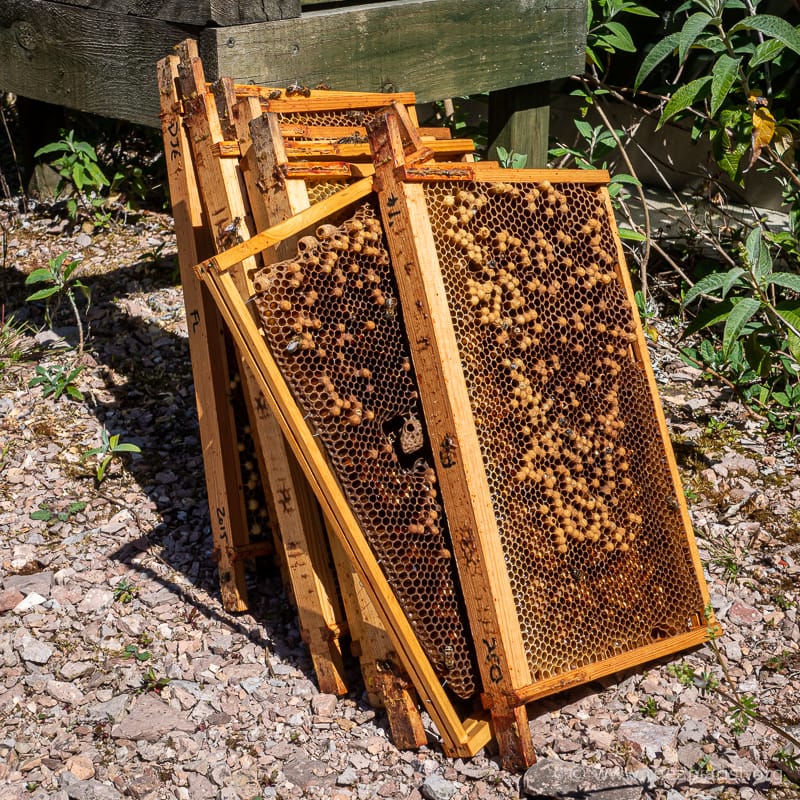
Join the discussion ...